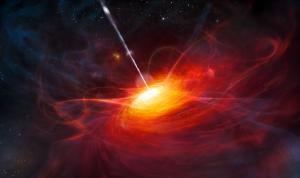Blog
Free Willy
28 February 2014
 ESO/M. Kornmesser
ESO/M. KornmesserThere’s a story going around the popular press about using quasars to determine whether free will exists. This stems from an MIT press release which talks about using quasars to “close the free will loophole.” Needless to say, the actual paper1 published in Physical Review Letters isn’t really about free will, but rather about an interesting effect of quantum mechanics. Obviously you have no choice but to keep reading.
The paper is about quantum entanglement, specifically an experiment known as the Einstein-Podolsky-Rosen (EPR) experiment. Suppose we have a mischievous mutual friend. She decides to prank us by sending sending each of us one member of a pair of gloves. She packs each glove in a box and mails one to each of us. We find out about the prank, so we both know that we’re getting one glove of a pair. But until either of us open our respective box, neither of us know which glove we have. Once the box arrives at your door, you open it up, and find you have the left glove. At that moment you know I must have the right glove.
This is the basic idea of the EPR experiment. For gloves it isn’t a big deal, because from the get-go the left glove was heading your way. You just didn’t know you were getting the left glove. That’s because gloves are not quantum things. In the quantum regime, things get much more strange. In quantum theory, things can be in an indefinite state until you observe them. It would be as if our boxes contained a pair of something (gloves, shoes, salt and pepper shakers, etc.) but it is impossible to know what specific something until one of us opens their box.
In quantum theory we would say the boxes contain a superposition of possible things, and the outcome only becomes definite when the outcome is observed. Now even though you can’t know what specific object you have, you know that I must have its pair. So if you open the box to find a red right shoe, you know immediately that I must have a red left shoe. We both know this without opening the box, so we can say that the outcomes of opening our boxes are entangled. Knowing the contents of one box tells us the contents of the other. We’ve actually done this experiment with photons, atoms and the like, and it really works.
Of course this is really hard to wrap your head around. If I’m thousands of miles away from you, and I open my box to find a salt shaker, I know you must have a pepper shaker. But your box couldn’t have known that until I opened the box. How is that possible? How can the opening of my box instantly affect your box thousands of miles away? Do the boxes communicate faster than light? (No.) Is there some secret (hidden variable) so that the boxes know what they will become when observed? (No.) That is part of what makes entanglement so strange, and the EPR experiment so popular.
 Jason Gallicchio, et al
Jason Gallicchio, et alNow the standard interpretation of this experiment is that it shows that fundamentally things are quantum mechanical. The experiments we’ve done have pretty much eliminated any possibility for things like hidden variables or faster than light communication. Usually this is done by waiting until the two “boxes” are sent on their way, and then use a random number generator to determine whether you test for “gloves” or “shoes” or whatever. Since the choice of what to look for is random, and that choice is made after the experiment has started, there is no way for the system to have advance knowledge of the outcome.
But if you really want to be picky, you could argue that while the experiment is being set up, there is plenty of time for the system to know what is going on. Technically, the experiment, random generator, and scientist are all “entangled” as a single system, so the outcome may be pre-biased. What looks like a random choice made after the experiment started may not actually be random. This is known as the setting independence problem. It is generally seen as far fetched, but technically it hasn’t been experimentally eliminated.
This new paper proposes a way to address this issue. Instead of using a random generator, you use light from distant quasars. The fluctuations of light from quasars billions of light years away would then determine what to test for, rather than a local random generator. The fluctuations began billions of years before the experiment was even thought of, so there is no way for the system to be biased. This idea isn’t new, but the authors have presented a realistic way to actually do the experiment.
Needless to say, this doesn’t really deal with existence or non-existence of free will. Philosophers are still likely to debate that topic whatever the outcome of this experiment. What this experiment will do is test a basic feature of quantum mechanics on a cosmic scale. We expect the outcome to be the same as before, but the fact that we could actually do the experiment is pretty cool.
Gallicchio, Jason, Andrew S. Friedman, and David I. Kaiser. “Testing Bell’s inequality with cosmic photons: Closing the setting-independence loophole.” Physical review letters 112.11 (2014): 110405. ↩︎